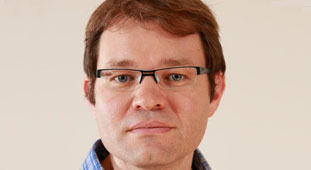171014 Researchers reach `paradigm shift’ in understanding potassium channels
Published On Fri 17 Oct 2014 by Roddy Isles

A new discovery relating to one of the most common processes in human cells is being described as a `paradigm shift’ in understanding.
Researchers at the University of Dundee, the Max Planck Institute for Biophysical Chemistry, the University of Göttingen and the University of Oxford have observed ion permeation in potassium channels which does not follow previously predicted pathways.
They have published the results of their research in the journal Science.
Potassium channels are tiny pores that stud the surface of almost all cell types in the human body, playing a role in the transmission of signals between brain cells and also helping control the frequency of our heartbeat. When they are not working properly they are implicated in a range of diseases, including neurodegenerative conditions and heart disease.
The channels allow the passage of potassium ions in an extremely rapid-fire opening and closing of the channel, acting as highly efficient filters.
The previous theory in this field was part of a project which led to the award of the 2003 Nobel Prize in Chemistry to the American biochemist Roderick MacKinnon. His work proposed that the ions were separated by water as they passed through the channel and that ion-to-ion contact was unlikely due to high electrostatic repulsion.
The research team working on the new project have found a completely different scenario, using advances in technology to reveal the fundamental physical principles that facilitate the channels’ operation.
Previous work examining the activity of potassium channels was only possible from looking at static or `closed-state’ crystal structures. Advances in computing have allowed researchers to now look at the channels ‘in action’which have provided much more detail and revealed the workings of the channels.
Using computer simulations at the atomistic scale and including a transmembrane voltage, they found that water is not co-transported through the channels with ions and is not needed to separate the potassium ions. They found that pairs of potassium ions were stably formed and then passed through the channel, with electrostatic repulsion driving the startling efficiency of the process.
“Our findings explain how potassium flux is able to happen at the maximum physically attainable speed, which is vital for the fast response of neurons,” said Dr Ulrich Zachariae, Reader in Computational Biophysics and Drug Discovery at the University of Dundee.
“This is a paradigm shift in the field. It changes our understanding of how these hugely important channels work. These channels are tremendously important as they are active in all cells so it is vital that we understand how they work.”
NOTES TO EDITORS
Life Sciences at Dundee
With more than 900 scientists, research students and support staff from 62 countries and external funding in excess of £50million per annum, the College of Life Sciences at the University of Dundee is one of the largest and most productive Life Sciences research institutes in Europe. The College has an international reputation for its basic and translational research and was recognised in the 2011 Biotechnology and Biological Sciences Research Council Excellence with Impact Awards for 'Greatest Delivery of Impact'. The University of Dundee is the central hub for a multi-million pound biotechnology sector in the east of Scotland, which now accounts for 16% of the local economy. www.dundee.ac.uk
Roddy Isles
Head of Press
TEL: 01382 384910
MOBILE: 07800 581902
E-MAIL: r.isles@dundee.ac.uk